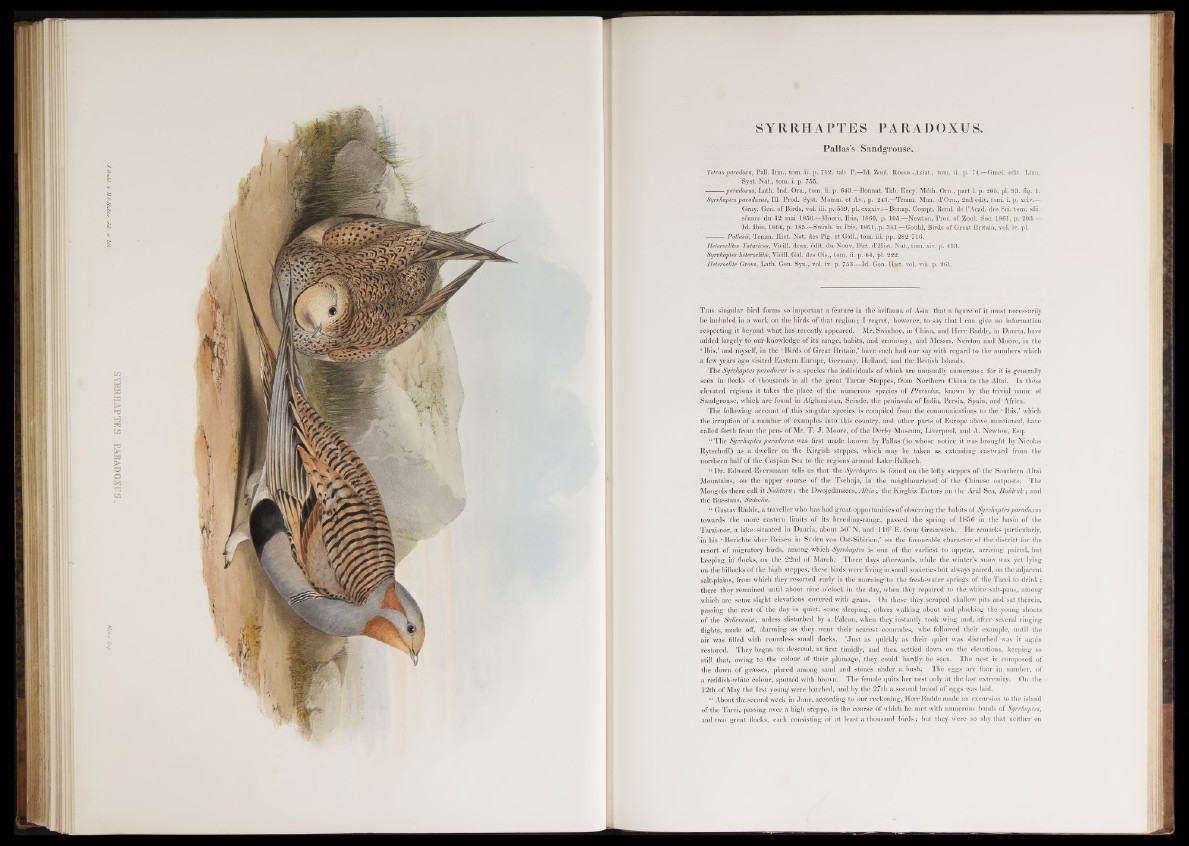
SYRRHAPTES PARADOXUS.
Pallas’s SandgTouse.
Tetrao paradoxa, Pall. I tin., tom. ii. p. 712, tab. F.—Id. Zool. Rosso.-Asiat., tom. ii. p. 74.—Gmel. edit. Linn.
Syst. Nat., tom. i. p. 755.
paradoxus, Lath. Ind. Om., tom. ii. p. 643.—Bonnat. Tab. Ency. Méth. Orn., part i. p. 205, pi. 93. fig. 1.
Syrrhaptes paradoxus, 111. Prod. Syst. Mamm. et Av., p. 243.—Temm. Man. d’Orn., 2nd edit. tom. i. p. xciv.—
Gray, Gen. o f Birds, vol. iii. p. 519, pl. cxxxiv.—Bonap. Compt. Rend, de l’Acad. des Sci. tom. xlii.
séance du 12 mai 1856.—Moore, Ibis, 1860, p. 105.—Newton, Proc. of Zool. Soc. 1861, p. 203.—
Id. Ibis, 1864, p. 185.—Swinh." in Ibis, 1861, p. 34-1.—Gould, Birds o f Great Britain, vol. iv. pi.
-—— Pallasii, Temm. Hist. Nat. des Pig. et Gall., tom. iii.. pp. 282-716.
Heteroclites Tataricus, Vieill. deux. edit, du Nouv. Diet. d’Hist. Nat., tom. xiv. p. 453.
Syrrhaptes heteroclitee, Vieill. Gal. des Ois., tom. ii. p. 64, pi. 222.
■Heteroclite Grous, Lath. Gen. Syn., vol. iv. p. 753.—Id. Gen. Hist. vol. viii. p. 261.
T h i s singular bird forms so important a feature in the avifauna of Asia that a figure of it must necessarily
be included in a work on the birds of that region ; I regret, however, to say that I can give -no information
respecting it beyond what has recently appeared. Mr. Swinhoe, in China, and Herr Radde, in Dauria, have
added largely to our knowledge o f its range, habits, and economy ; and Messrs-. Newton and Moore, in the
* Ibis/ and myself, in the * Birds of Great Britain/ have each had our say with regard to the numbers which
a few years ago visited Eastern Europe, Germany, Holland, and the British Islands.
The Syrrhaptes paradoxus is a species the individuals of which are unusually numerous ; for it is generally
seen in flocks of thousands in all the great Tartar Steppes, from Northern China to the Altai. In these
elevated regions it takes the place of the numerous species of Pterocles, known by the trivial name of
Sandgrouse, which are found in Afghanistan, Scinde, the peninsula of India, Persia, Spain, and Africa.
The following account of this singular species is compiled from the communications to the * Ibis/ which
the irruption of a number of examples into this country, and other parts of Europe above mentioned, have
Called forth from the pens of Mr. T. J. Moore, o f the Derby Museum, Liverpool, and A. Newton, Esq.
“ The Syrrhaptes paradoxus was first made known by Pallas (to whose notice it was brought by Nicolas
Rytschoff) as a dweller on the Kirgish steppes, which may be taken as extending eastward from the
northern half of the Caspian Sea to the regions around Lake Balkach.
“ Dr. Edward Eversmann tells us that the Syrrhaptes is found on the lofty steppes of the Southern Altai
Mountains, on the upper course of thè Tschuja, in the neighbourhood of the Chinese outposts. The
Mongols there call it Nukturu ; the Dwojédanzees, Altin ; the Kirghiz Tartars on the Aral Sea, Buldruk ; and
the Russians, Sadscha.
“ Gustav Radde, a traveller who has had great opportunities o f observing the habits of Syrrhaptes paradoxus
towards the more eastern limits of its breeding-range, passed the spring of 1856 in the basin of the
Tarai-nor, a lake situated in Dauria, about 50° N. and 116° E . from Greenwich. He remarks particularly,
in his ‘ Berichte über Reisen in S f den von Ost-Sibirien/ on the favourable character of the district for the
resort of migratory birds, among which Syrrhaptes is one of the earliest to appear, arriving paired, but
keeping in flocks, on the 2*2nd o f March. Three days afterwards, while the winter’s snow was yet lying
on the hillocks o f the high steppes, these birds were living in small societies but always paired, on the adjacent
Salt-plains, from which they resorted early in the morning to the fresh-water springs of the Tarei to drink ;
there they remained until about nine o’clock in the day, when they repaired to the white salt-pans, among
which are some slight elevations covered with grass. On these they scraped shallow pits and sat therein,
passing the rest of the day in quiet, some sleeping, others walking about and plucking the young shoots
of the Salicornice, unless disturbed by a Falcon, when they instantly took wing and, after several ringing
flights, made off, alarming as they went their nearest comrades, who followed their example, until the
air was filled with countless small flocks. 'Just as quickly as their quiet was disturbed was it again
restored. They began to descend, at first timidly, and then settled down on the elevations, keeping so
still that, owing to the colour of their plumage, they could hardly be seen. The nest is composed of
the down of grasses, placed among sand and stones under a bush. The eggs are four in number, of
a reddish-white colour, spotted with brown. The female quits her nest only at the last extremity. On the
12th of May the first young were hatched, and by the 27th a second brood of eggs was laid.
“ About the second week in June, according to our reckoning, Herr Radde made an excursion to the island
of the Tarei, passing over a high steppe, in the course o f which he met with numerous bands of Syrrhaptes,
and two great flocks, each consisting of at least a thousand birds ; but they were so shy that neither on